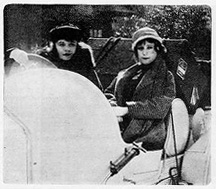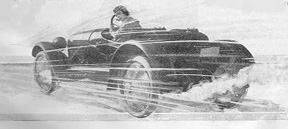But it was not only the actresses who had grown up with movies since the nickelodeon days who distinguished themselves with their daring driving in films. Stage stars like Elsie Janis and Billie Burke found that the new medium provided them with an opportunity to take to real highways in automobiles,a departure from the artificiality of the devices to simulate moving cars on stage.
In The Caprices of Kitty, released in early 1915, the versatile Elsie Janis emulated Mabel Normand by not only starring but also writing and co-directing (with Phillipps Smalley) her film debut for the Bosworth Company. Elsie played a high-spirited tomboy whose many exploits included driving a racing car. (34) Elsie's 1919 film for Selznick, A Regular Girl, written by Frances Marion, gave the actress yet another opportunity to race. Cameraman Hal Sintzenich noted in his diary for September 25, 1919 that he "took scenes of Miss Janis driving a car at 60 m.p.h. round the fountain in a circle" on location in Tarrytown, New York, near the actress's home. (35)
Billie Burke also made her screen debut behind the wheel of a car as the star of Thomas Ince's memorable 1915 production, Peggy. The film casts Billie as a hoydenish American heiress who returns to her ancestral village in Scotland and upsets the staid Presbyterian community by driving her racing car at high speed. In one scene, Billie dons overalls to repair her auto and, in a famous shot, just her dainty heels are seen protruding from the car as she "gets out and gets under." For an article that appeared in Sunset Magazine, Charles K. Field visited the set of Peggy |
| |
"where the Pacific Ocean laps the waterfront of Inceville, to see Miss Burke, in boy's clothes, dash up the street of a Scotch village at the wheel of a gasoline racer, pelted by a property rain and missiles from the hands of a hundred villagers; to see her leap from the auto and strive, in an atmosphere of mud and tomatoes, to calm the mob in a village which had been turned topsy-turvy by a young American tomboy heiress in a high-powered car; to see her washing away the stains of battle neck-deep in a marble fountain (made in Inceville)."(36) |
|
 Billie Burke put the pedal to the metal in other silents including the Famous Players light comedy, In Pursuit of Polly, filmed on location in Oyster Bay in 1918. The story has Billie engaged to three men at once. When her father orders her to make a final decision, she says the first suitor to overtake her in her racing car will be the one she marries. After some daredevil driving, she manages to elude her pursuers. Abandoning her car, she soon becomes involved in international complications vis-a-vis a German spy and the United States secret agent who becomes her love interest. (37) Billie Burke put the pedal to the metal in other silents including the Famous Players light comedy, In Pursuit of Polly, filmed on location in Oyster Bay in 1918. The story has Billie engaged to three men at once. When her father orders her to make a final decision, she says the first suitor to overtake her in her racing car will be the one she marries. After some daredevil driving, she manages to elude her pursuers. Abandoning her car, she soon becomes involved in international complications vis-a-vis a German spy and the United States secret agent who becomes her love interest. (37)
Elsie Janis and Billie Burke had been among the prominent stage stars who had owned automobiles in the first decade of the new century. But during the earliest years of the cinema, when players received no billing and had much lower salaries than their contemporaries in the theater, few film people could afford to own cars. It was not until around 1912 and 1913 with the development of the star system in motion pictures that many leading actors and actresses in films began buying cars. The film stars' latest acquisitions proved excellent grist for the publicity machine and were constant topics, along with tales of their driving, in the fan and trade press columns. (Marguerite Clark and Theda Bara were among the few actresses who never drove their own cars. Significantly, they were also among the more conservative in their attitude towards women's rights with Marguerite opposing woman suffrage and Theda remaining neutral on the issue in contrast to many of the actresses of the teens.)
In one of the early columns of the era from 1914, the readers of The New York Dramatic Mirror learned the following about the beautiful, popular dramatic star, Ethel Clayton, who was then working for the Lubin Company in Philadelphia and delighted in driving her car: |
| |
"ETHEL CLAYTON, now playing leads in the Lubin productions of the Charles Kleine plays, is a bona-fide motorist. She really owns a car, which she values all the more because purchased with her savings. When not at the studio, the actress can be seen spinning through the park in her gray-and-red motor at a rate of speed (whisper it!) which no speedometer can register."(38) |
|
| And in a column about the doings at the Famous Players studio in New York in 1917, another great dramatic star's automotive tastes were a subject of the latest gossip: |
| |
"Some time ago automobile row rocked and swayed to the news that Pauline Frederick had purchased a nile-green Peerless roadster as the first sign of spring. Miss Frederick, having possessed the roadster for a few weeks, characteristically tired of it and sent it to the shop to be painted a khaki tan. In the meanwhile, in order that she could get from Thence to Thither in an irreducible minimum of time, the Famous Players-Paramount star purchased a specially built racing Simplex, which is positively guaranteed to make one hundred miles an hour on the lowest discoverable gear. Incidentally, when the Frederick heel alights upon the cut-out, the noise of the recent British bombardment at Messines fades into pale pink insignificance."(39) |
|
| There were many humorous incidents reported about the stars' predilection for fast driving like the story from 1916 about Louise Huff, an actress originally with Lubin who was then working at Famous Players: |
| |
"Louise Huff was arrested and fined recently for speeding while en route to the Famous Players studios. With the incident very fresh in her mind, she was proceeding slowly along Riverside Drive on a certain morning, when a policeman suddenly leaped on the running board of her car. Before the terrified Miss Huff was able to finish a gasping protest to the effect that she was only going ten miles an hour, the officer told her to whirl him along to Eighty-sixth street as fast as possible. Without stopping to ask questions Louise blithly stood on the accelerator and fled down the Drive at express speed, smiling defiantly at every patrolman she passed. The sudden desire of the minion of the law to go elsewhere than where Miss Huff encountered him is explained by the fact that it was the first day of the traction strike, and he had received a hurry-up call to report at the cross-town line."(40) |
|
| The subject of autos also often came up in interviews with the stars. Universal star and director Grace Cunard declared: "I am a perfect devotee of motoring and simply must take time for a spin in my Lozier car. No speed is great enough to please me." (41) Lasky star and Griffith veteran Blanche Sweet was asked by a Photoplay interviewer about motoring shortly after she acquired her first car in late 1914, a white National touring car she had repainted with black stripes: |
| |
"Of course I like it and it is really very thrilling to drive downtown in the traffic. I just learned to drive a month ago and some pedestrians have had some very narrow escapes. I almost ran down a man yesterday. I thought at first he was Mr. Griffith's press agent whom I dodged for about a year and was just a little disappointed when I saw it wasn't. Of course I would hate to hurt him, but I certainly would like to make him dodge just once."(42) |
|
 Billie Burke put the pedal to the metal in other silents including the Famous Players light comedy, In Pursuit of Polly, filmed on location in Oyster Bay in 1918. The story has Billie engaged to three men at once. When her father orders her to make a final decision, she says the first suitor to overtake her in her racing car will be the one she marries. After some daredevil driving, she manages to elude her pursuers. Abandoning her car, she soon becomes involved in international complications vis-a-vis a German spy and the United States secret agent who becomes her love interest. (37)
Billie Burke put the pedal to the metal in other silents including the Famous Players light comedy, In Pursuit of Polly, filmed on location in Oyster Bay in 1918. The story has Billie engaged to three men at once. When her father orders her to make a final decision, she says the first suitor to overtake her in her racing car will be the one she marries. After some daredevil driving, she manages to elude her pursuers. Abandoning her car, she soon becomes involved in international complications vis-a-vis a German spy and the United States secret agent who becomes her love interest. (37)